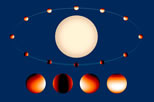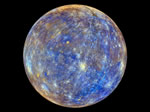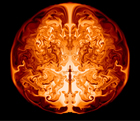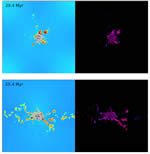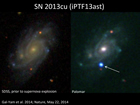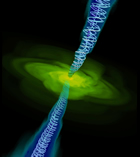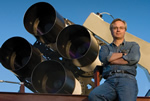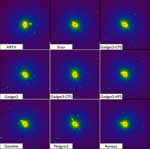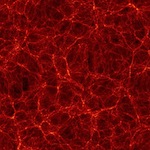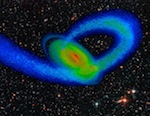Word doc
PDF (formatted and ready to go as a single newsletter page)
Disk Galaxies: Settling for Beauty with Age
Today, the majority of local galaxies forming stars are rotating disks, such as our own Milky Way or the Andromeda Galaxy (M31). Disk galaxies are well ordered: there is a defined plane to the galaxy and most stars and gas revolve in one direction around its center.
Many astronomers had thought that disk galaxies had largely finished forming by about 8 billion years ago, as indicated by the rates at which stars are formed in the Universe. Therefore, they assumed that distant, much younger disk galaxies are not all that different from nearby ones.
Spectroscopic observations of distant galaxies taken with the 10-meter telescopes at the W. M. Keck Observatory on Hawaii, when combined with images taken by the Hubble Space Telescope plus supercomputer simulations to help interpret the observations, however, together reveal a surprise. The motions of gas inside distant galaxies has been continuously settling down over the last 8 billion years while galaxies slowly assume the familiar flat disk shape of nearby galaxies.
This finding is announced in an article titled “The Epoch of Disk Settling: z ~ 1 to Now” by Susan A. Kassin and 13 collaborators, published in the October 20, 2012 issue of The Astrophysical Journal.

This plot shows the fractions of settled disk galaxies in four time spans, each about 3 billion years long. There is a steady shift toward higher percentages of settled galaxies closer to the present time. At any given time, the most massive galaxies are the most settled. More distant and less massive galaxies on average exhibit more disorganized internal motions, with gas moving in multiple directions, and slower rotation speeds. Credit: NASA/Goddard Space Flight Center
From chaos to calm
“Galaxies are like human adults,” said Kassin, a postdoctoral fellow at NASA’s Goddard Space Flight Center in Greenbelt, MD. “Many have had exciting youths marked by intense interactions with other galaxies, with a lot of growth spurts in mass, new stars, and heavy elements. But chaotic growth slows down as galaxies mature, and they become more organized and calmer inside.”
Because looking far out into the depths of space is the equivalent of looking back in time, the redshift z is how astronomers measure both age and distance in the universe. A redshift of z = 1 corresponds to about 8 billion years ago, when the universe was about 5 billion years old. “It’s almost like a mantra. People say that the Hubble sequence is in place by z = 1,” Kassin said. The Hubble sequence is a diagram—originally devised by Edwin Hubble in 1926—for classifying the visible shapes of galaxies.
Kassin and her 13 coauthors—six from the University of California—found the observational evidence suggests something quite different. The internal motions of gas within galaxies back in time are far more disordered, moving every which way rather than neatly revolving around the centers of galaxies. Moreover, they found that the Hubble sequence of well-ordered disk galaxies gradually evolved from earlier more chaotic forms over the last 8 billion years. “It is clear the Hubble sequence was not in place at a redshift of 1,” Kassin said.
Three keys to discovery
“Sample selection can be quite insidious,” explained co-author Benjamin Weiner of the University of Arizona. In past studies of galaxy evolution, researchers typically studied only those galaxies that are recognizably disk-shaped, excluding any that are obviously disturbed. But shape criteria can bias the result. In contrast, Weiner said, “we included all galaxies bright enough to give spectra from which the motions inside galaxies could be measured.”
Second, past studies examined only the speed at which the stars revolve around the centers of galaxies. “We also measured the disordered motions of clouds of gas in galaxies,” Kassin continued.
Third, the coauthors studied more than 500 galaxies, yielding good statistical correlations. The collaborators also performed mock observations on computer-simulated images of merging disk galaxies in various stages of disorder and at various distances. “We followed exactly the same procedures of spectral measurements as with observations of real galaxies,” explained collaborator Joel R. Primack of the University of California, Santa Cruz, “to measure the extent to which effects such as the observed sizes of galaxies and the blurring effects of the Earth’s atmosphere play in the observations.” –Trudy E. Bell, M.A.
Further reading:
Links to the paper in The Astrophysical Journal and to several NASA videos appear at http://hipacc.ucsc.edu/GalaxyDiskSettling.html .
The University of California High-Performance AstroComputing Center (UC-HIPACC), based at the University of California, Santa Cruz, is a consortium of nine University of California campuses and three Department of Energy laboratories (Lawrence Berkeley Laboratory, Lawrence Livermore Laboratory, and Los Alamos National Laboratory). UC-HiPACC fosters collaborations among researchers at the various sites by offering travel and other grants, co-sponsoring conferences, and drawing attention to the world-class resources for computational astronomy within the University of California system. More information appears at http://hipacc.ucsc.edu .
